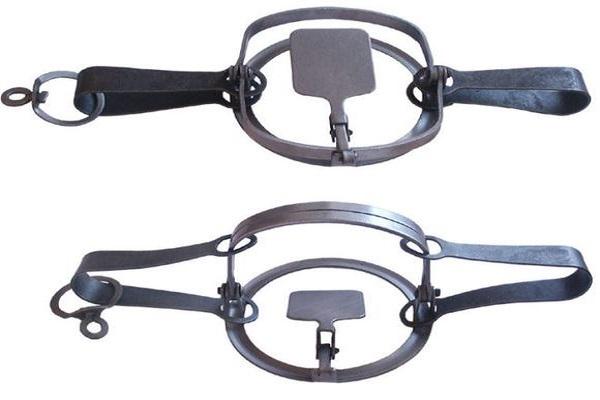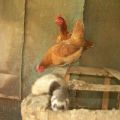How to catch a ferret in a chicken coop and the best methods of dealing with the animal
This cute animal, the hero of many cartoons, is a dangerous predator capable of destroying all poultry in a short time. Smart owners should protect chickens from predators in advance and know how to catch a dodgy and cunning ferret if it appears in the chicken coop. There are enough proven and effective ways to do this.
What you need to know about the predator
It is a mammal belonging to the Cunyi family. The body is elongated, covered with thick, soft, short fur (from light, beige to dark brown). It ends with a fluffy tail, up to 20-25 centimeters long. The legs are stocky, short, so the body of the ferret looks squat. The animal has an oval head, a small muzzle is slightly elongated, with a dark pattern in the form of a mask.
The ferret is very mobile and active - this dexterous animal easily crawls into any crevice, climbs trees, roofs of buildings, digs tunnels and burrows and swims well in the water. With its small size (up to 50 centimeters in length), this small, but very agile, smart and cunning animal is capable of destroying an entire chicken herd overnight.
He can get into any, even the seemingly strongest and most durable chicken coop. Moreover, the ferret eats only one bird, and kills the rest for future use, in reserve, so it is a doubly dangerous predator. The animal kills the chickens by strangling them, gnawing their throats.
Often traces of his stay in the poultry house are found by the owners only when it is getting late - the whole bird is mercilessly killed and spoiled.

Signs of appearance
The ferret is a nocturnal, secretive predator, so it will be quite problematic to catch him by surprise. Therefore, it is necessary to know and take into account the signs of its appearance, otherwise in just a few days all the chickens can be found dead.
Signs of appearance:
- detection of a narrow tunnel under the wall of the chicken coop or a hole in the roof in the case of reed coverage;
- finding a chicken or an adult chicken with a gnawed throat, as well as parts of a bird: severed paws, heads, feathers and pools of blood;
- when the owner enters the chicken coop in the morning, the chickens continue to perch, behave restlessly, refuse to go down to the floor.

How to get rid of a ferret in a chicken coop?
The ferret, having settled in the chicken coop, will consider it their "legal" hunting grounds. Moreover, even after destroying all the birds in the hen house, he will come for prey again. Therefore, regular updating of the bird population will not help - everything will be repeated again.
The only correct way out is to catch and destroy the predator.
Homemade traps
You can fight the animal by making effective traps yourself. You will need a steel cage or wooden box with a slam door that the ferret can easily fit into. A bait is placed inside the trap, which is a delicacy for the animal, usually a part of a bird's carcass is placed. The door is adjusted so that it slams shut the moment the ferret grabs the bait inside the cage.

They put a trap in the chicken coop at night, and in the morning they go to check if a predator has been caught. In case of success, the question arises before a person - whether to take the life of the animal or to act more humanely? When choosing the second option, he is taken away several kilometers from the chicken coop and released, preferably in the forest. But this method of fishing has its drawbacks that you need to know before installing:
- the bait attracts other animals and birds;
- the ferret often chooses live prey instead of dead carcasses that act as bait;
- if the proportions of the bait are incorrectly calculated or there is a failure of the mechanism that slams the door, then the animal will never come close to the trap again.
Modern technical means
Technological progress does not stand still, today there are devices that can easily rid the site of uninvited guests. Modern ultrasonic scarers (like Tornado 1200) produce low-frequency sounds that are inaudible to the human ear. Ferrets do not tolerate them and prefer to bypass the area protected in this way.

Light and sound scarers will help scare off a night predator. When the animal approaches the chicken coop, they begin to blink brightly and make unpleasant, loud sounds. And a cautious ferret will find it necessary not to approach a structure protected in this way. They work autonomously, powered by rechargeable batteries.
But it is important to regularly monitor the charge level so that they are always in a "combat-ready" condition.
Traps
If a tunnel is found under the wall of the hen house, the owners should not fill it up or close it up. Firstly, the predator will dig a new one without any problems, and secondly, the discovered tunnel is an excellent opportunity to bring the ferret out by catching it. Traps are placed in a chaotic manner near the entrance. But in an empty, unprepared mechanism, a cunning ferret is unlikely to get caught. In order to interest the predator, a dead bird is placed next to it, and the trap itself is sprinkled with blood and sprinkled with feathers.
It is necessary to set traps taking into account the hunting habits of the animal - usually grabbing the victim with its teeth, the ferret moves back. Then he can get into one of the pre-established traps along the way.

It is important to pre-lubricate the mechanism with fresh manure or sprinkle it with spruce broth so that the ferret does not smell the human smell. The installation of the trap itself is carried out only with gloves. But even such measures do not give a complete guarantee of success in catching a dodgy animal.
Pet help
If the animal appears, pets - cats and dogs - can come to the rescue. But at the same time, it is important to remember that for an affectionate and domestic cat, a battle with a seasoned, armed with sharp teeth, dodgy ferret can end in disaster. Another thing is cats accustomed to life and hunting in the yard, the so-called "rat catchers".
They are closed at night in the chicken coop, and in the morning the result of the hunt is checked. But entrusting the security of the house to one or more dogs can be quite effective. Ferret catching is especially good for nimble, hunting breeds, such as the jagdterrier.

Folk ways
In rural life, over the years of fighting a predator, several ways have been developed to ward off or catch a ferret. Here are the main ones:
- goat skins are hung in the hen house, which have a specific, unpleasant, pungent odor that frightens off the animal;
- in places inaccessible to birds, the walls of the hen house are coated with tar - the ferret does not tolerate such a smell, he will bypass the hen house;
- equip traps, characterized by simplicity, from improvised means. Set up a large saucepan, boil, or bucket on a wobbly support. They put meat bait inside, which the ferret will knock down when it tries to eat the treat, and the fallen bucket will cover it. All that remains is to gently lift and catch the animal.
It is worth noting that folk remedies are especially effective in combination with other, more modern, methods.

Can you catch and tame the beast?
The ferret is an intelligent and cunning animal that, over time, lends itself to training, he is able to perform various tricks. At first, the animal must be kept in a cage, and then it can be released freely. Among other things, a domesticated ferret can scare away its wild brethren.
How to prevent the destruction of birds
To prevent the death of birds, it is necessary to perform a number of complex actions, consisting of the following factors:
- strengthening, preparation of the chicken coop;
- establishment of cats or dogs on the site;
- garbage collection and the absence of impromptu dumps;
- regular check for undermines;
- observation of the appearance of chickens;
- installation of modern scarers.

How to avoid appearing?
Getting your ferret into the house can be made as difficult as possible. To do this, first, a concrete floor is poured, since the main way of penetration of the predator is by digging. You can also make a wooden floor, but sheathe it with sheets of such material that the ferret cannot gnaw through. You need to check for gaps in the walls, near the floor, as well as between the roof and walls.
The ventilation holes are covered with a mesh, and the reliability of the roof is also checked. If the owners do not have the opportunity to make a strong floor, then the poultry house is fenced with a fine mesh, burying it half a meter into the ground.
It is worth keeping an eye on the cleanliness of the entire site - dumps of construction and organic waste attract the animal, and he will gladly settle nearby.









